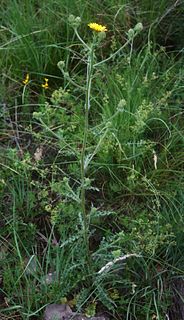
The smooth hawksbeard, Crepis capillaris, is a species of flowering plant in the dandelion tribe within the sunflower family, native to Europe. It has become naturalized in other lands and is regarded as a weed in some places.
Ernest Brown Babcock was an American plant geneticist who pioneered the understanding of plant evolution in terms of genetics. He is particularly known for seeking to understand by field investigations and extensive experiments, the entire polyploid apomictic genus Crepis, in which he recognize 196 species. He published more than 100 articles and books explaining plant genetics, including the seminal textbook Genetics in Relation to Agriculture. The standard author abbreviation Babc. is used to indicate this person as the author when citing a botanical name.

Crepis, commonly known in some parts of the world as hawksbeard or hawk's-beard, is a genus of annual and perennial flowering plants of the family Asteraceae superficially resembling the dandelion, the most conspicuous difference being that Crepis usually has branching scapes with multiple heads. The genus name Crepis derives from the Greek krepis, meaning "slipper" or "sandal", possibly in reference to the shape of the fruit.

Crepis acuminata is a North American species of flowering plant in the daisy family known by the common name tapertip hawksbeard. It is native to the western United States where it grows in many types of open habitat.

Crepis intermedia is a North American species of flowering plants in the daisy family known by the common name limestone hawksbeard. It is native to the Pacific Northwest, Columbia Plateau, Great Plains and Southwestern regions of western North America.

Crepis modocensis is a species of flowering plant in the daisy family known by the common name Modoc hawksbeard.

Crepis occidentalis is a North American species of flowering plant in the daisy family known by the common names western hawksbeard, or largeflower hawksbeard. It is native to western Canada and the western United States.

Crepis runcinata is a North American species of flowering plant in the daisy family known by the common name fiddleleaf hawksbeard. It is native to western and central Canada, the western and central United States and northern Mexico (Chihuahua).

Crepis paludosa, the marsh hawk's-beard, is a European species of plants in the dandelion tribe within the sunflower family. It is widespread across much of Europe with isolated populations in Iceland, the Ural Mountains, and the Caucasus.

Crepis tectorum, commonly referred to as 'the narrowleaf hawksbeard' or 'narrow-leaved hawk's-beard', is an annual or winter annual plant between 30 and 100 centimetres in height. Originating in Siberia before being introduced to Canada in 1890, the Narrowleaf hawksbeard's is an invasive species. Maintaining one branched, hairless and leafy stem during maturity, the Narrowleaf hawksbeard has yellow leaves which are arranged in an alternate manner and less than 0.5 inches (13 mm) wide.
Crepis zacintha, common name striped hawksbeard, is a plant species native to southern Europe but now naturalized on roadsides and other disturbed sites in Texas, Israel, Cyprus, and the United Kingdom.
Crepis atribarba is a North American species of flowering plant in the daisy family known by the common names slender hawksbeard and dark hawksbeard. It is native to western Canada and the western United States It has been found in British Columbia, Utah, Washington, Oregon, Nevada, Idaho, Alberta, Montana, Wyoming, Colorado, Saskatchewan, and Nebraska.

Crepis biennis is a European species of flowering plant in the daisy family with the common name Rough Hawksbeard. It is native to Europe and Asia Minor, as well as being sparingly naturalized in scattered locations in the northeastern United States and on the island of Newfoundland in eastern Canada. Many people think that they are dandelions because they look so alike but that is only because both are in the daisy family.

Crepis foetida is a European species of flowering plant in the daisy family with the common name stinking hawksbeard. It is widespread across much of Europe and Siberia, as well as being sparingly naturalized in scattered locations in the United States and Australia.

Crepis pannonica is a European species of flowering plant in the daisy family. It is native to eastern Europe and the Caucasus, as well as being sparingly naturalized in the State of Connecticut in the northeastern United States.

Crepis pulchra is a European species of flowering plant in the daisy family with the common name smallflower hawksbeard. It is widespread across much of Europe as well as in Morocco, Algeria, and western and central Asia. It has also become naturalized in the parts of the United States and in the Canadian Province of Ontario.

Crepis rubra is a European species of flowering plant in the daisy family with the common name red hawksbeard or pink hawk's-beard. It is native to the eastern Mediterranean region and is widely cultivated as an ornamental. It became naturalized in a small region of the United States.

Crepis setosa, the bristly hawksbeard, is a European species of flowering plant in the daisy family. It has become naturalized in North America and occurs Washington, Oregon, California, Idaho, Montana, Texas, Arkansas, Missouri, Tennessee, Wisconsin, Ohio, Pennsylvania, New York, Connecticut and Vermont.

Crepis vesicaria is a European species of flowering plant in the daisy family with the common name beaked hawk's-beard. It is native to the Western and Southern Europe from Ireland and Portugal east as far as Germany, Austria, and Greece. It became naturalized in scattered locations in North America.
Crepis vesicariasubsp. taraxacifolia, the beaked hawksbeard, is a subspecies of flowering plant in the family Asteraceae. It is native to Europe and northwest Africa. It has become naturalized in scattered locations in the United Kingdom, North America, and Oceania.















